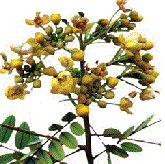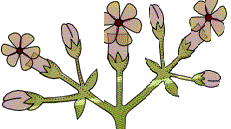Inflorescence in plant
A flower is a modified shoot wherein the shoot apical meristem changes to floral meristem.
Internodes do not elongate and the axis gets condensed.
The apex produces different kinds of floral appendages laterally at successive nodes instead of leaves.
When a shoot tip transforms into a flower, it is always solitary. The arrangement of flowers on the floral axis is termed as inflorescence.
Depending on whether the apex gets developed into a flower or continues to grow, two major types of inflorescences are defined as follows:
1. Racemose
In racemose type of inflorescences the main axis continues to grow, the flowers are borne laterally in an acropetal succession.
Examples : Mustard, snapdragon, gulmohar, wheat, barley, parsley, etc
2. Cymose
In cymose type of inflorescence the main axis terminates in a flower, hence is limited in growth. The flowers are borne in a basipetal order.
Examples : Night jasmine, Drosera, common European elder etc.
Cymose inflorescence can be further divided into four different groups :
1. Uniparous or Monochasial Cyme
the peduncle or main stem produces only one flower and stops growing. It produces one lateral branch at a time which also terminates after developing one flower and another succeeding branch at a time. Monochasial cyme can be classified into three types.
a. Helicoid : In this type the branches keep growing on the same side only and ultimately form a helix. Examples are Drosera, Hamelia, etc. Notably, there are two types of helicoid – drepanium and bostryx.
b. Scorpioid : when branches grow alternatively on both sides, it is known as monochasial scorpioid cyme. Two types of scorpioid include cincinnus and rhipidium.
c. Sympodial : It is a type of monochasial cyme where stems which are curved or zig-zag in the beginning but later on become straight and multiply to form the central axis.
2. Biparous or Dichasial Cyme
In this type of inflorescence, the main stem stops growing after the development of a terminal flower. However, two lateral branches originate from the main stem at the same time, and they too stop growing after producing a flower. The lateral branches may, in turn, produce two other branches. Examples of dichasial cyme include saponaria, jasmine, teal ixora and so on.3. Polychasical or Multiparous Cyme
Here the central axis or peduncle ends in a flower called the terminal bud. Then from the base of this terminal flower, two or sometimes more than two lateral flower producing branches originate. This is also called simple polychasium. It looks similar to umbel type inflorescence, but the difference between the two is that the terminal flower matures or opens first. Examples are calotropis, hamelia patens etc.4. Cymose Capitulum or Head
In this type, the peduncle or the main stem is in the shape of a circular disk. The formation is similar to a raceme head. The flowers are either sessile or sub-sessile which are arranged in a centrifugal order like a globose head. The globose head is also known as glomerule. Some examples are acacia, albizzia.Difference between Racemose and Cymose
| Racemose Inflorescence | Cymose Inflorescence |
|
|
| Arrangement of flowers are in acropetal order. | Flowers are in basipetal sequence. |
| Flower grow laterally on the peduncle. | The growth of flower is terminal and one-sided |
| The main stem experiences continuous growth. | The growth of main stem ends in the development of the flower at top |


